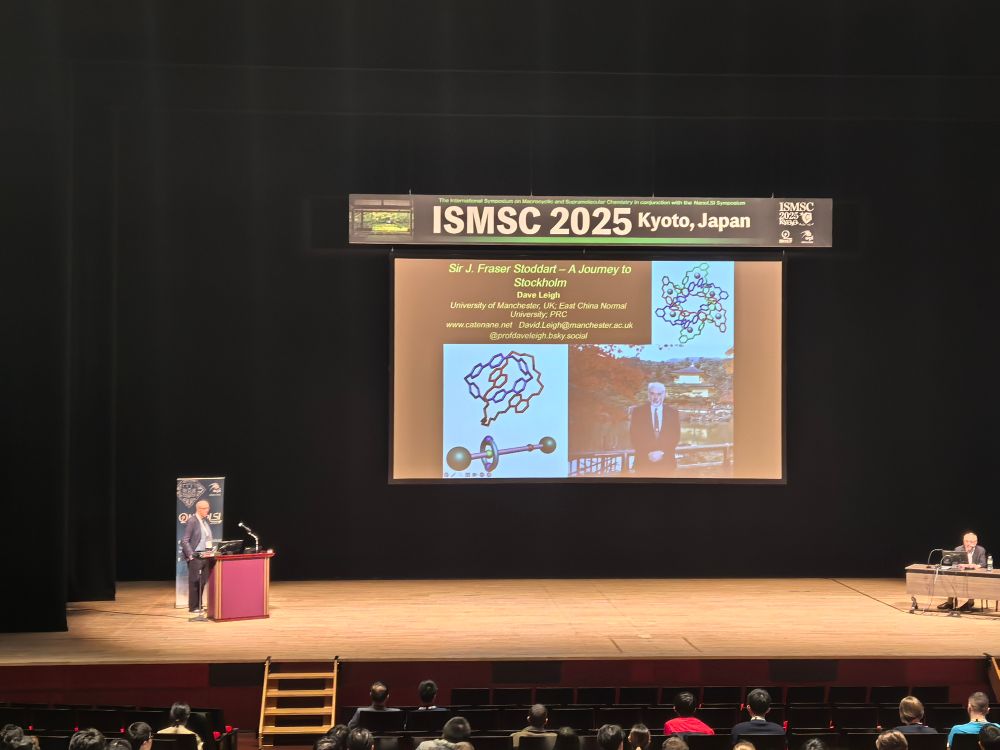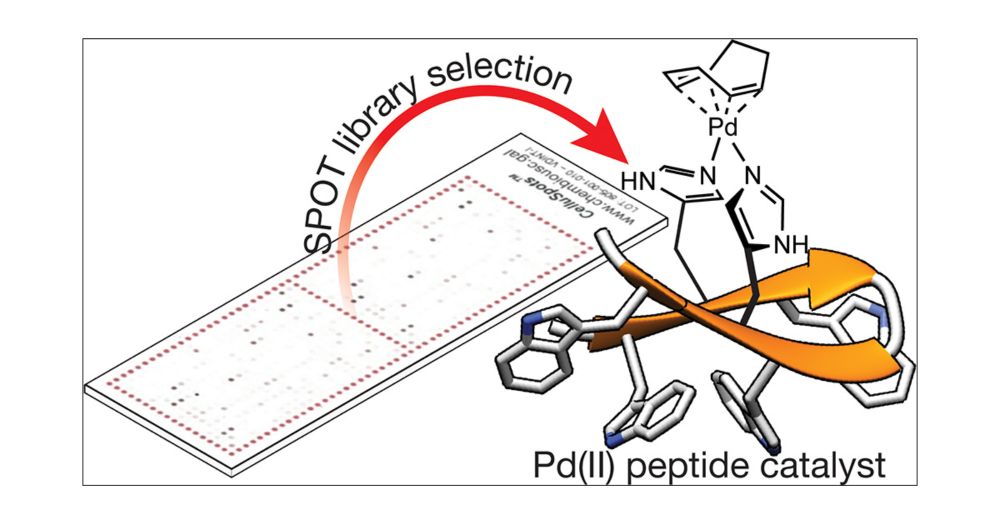
Our work on the unidirectional motion of a CD is now in the September issue of Chem and on the cover!
Many thanks to the whole team and @cp-chem.bsky.social for the highlight!
@ipcm-sorbonne.bsky.social @msollogoub.bsky.social @enxuliu.bsky.social
www.cell.com/chem/fulltex...
12.09.2025 14:55 — 👍 22 🔁 9 💬 1 📌 2

Hetero‐Hydrazone Photoswitches
Heterocycles dramatically change the performance of hydrazone photoswitches. Basic rings cause rapid thermal isomerization via tautomerization, while ones that can participate in H-bonding lower swit...
Congrats to Daniil & collabs from the Liu group at NTU on the #HOTpaper in @angewandtechemie.bsky.social bit.ly/4ncBOJm where we show how heterocycle basicity and H-bonding ability affect the photoswitching and thermal isomerization mechanism of hydrazone switches 🧪⚗️#chemsky #NSFfunded #molswitch
15.09.2025 14:38 — 👍 20 🔁 3 💬 0 📌 0


Our recent papers are now published back to back in issue 37 of @angewandtechemie.bsky.social supported by a front cover designed by @drawimpacts.bsky.social
#chemsky #openaccess
Read the papers here: onlinelibrary.wiley.com/doi/10.1002/...
onlinelibrary.wiley.com/doi/10.1002/...
10.09.2025 09:36 — 👍 13 🔁 2 💬 0 📌 1

Multiple Template Site Nitrogen Atom Deletions from Rotaxanes, Catenanes, and a Molecular Knot
We report the deletion of nitrogen atoms from multiple template sites in rotaxanes, catenanes, and a molecular knot. Nitrogen extrusion from secondary amines in the backbone of the interlocked structures is achieved using O-diphenylphosphinylhydroxylamine (DPPH), forming carbon–carbon bonds while largely maintaining the integrity of the original mechanical bonding. We find that DPPH gives improved yields (up to 51%) for nitrogen atom deletions from template sites in rotaxanes compared to an anomeric amide nitrogen-deletion reagent and overcomes a major substrate limitation in that, using DPPH, only one of the substituents of the secondary amine in the rotaxane axle needs to be radical-stabilizing. Multiple template site nitrogen atom deletions were accomplished from a range of mechanically interlocked architectures, despite the potential for dethreading, unlinking, and/or strand uncrossing during each successive deletion event. Highlights include the deletion of two template sites from a doubly threaded [3]rotaxane (37% yield) and [3]catenane (45%), quadruple N-deletion of amines from both rings of a [2]catenane (33%), and six N-deletions from the six amine groups in a molecular trefoil knot (7%). The combination of skeletal editing with template synthesis provides a general strategy for synthesis that significantly increases the structural diversity of interlocked molecules that are potentially accessible.
...Yet here in @jacs.acspublications.org Daniel, Qi, Jess & co show they can delete multiple template sites from rotaxanes, catenanes and a molecular knot, severing the strands multiple times, and still end up with mechanically interlocked molecules. Amazing!🤯 pubs.acs.org/doi/10.1021/...
29.08.2025 10:55 — 👍 27 🔁 3 💬 0 📌 1

2-Isocyanoanilines and their mono-Boc-protected derivatives
Among the variety of synthetically useful isocyanides, 2-isocyanoanilines have been scarcely reported in the chemical literature, despite the rich chemistry that expectedly could derive from the react...
🔓Don't miss this #OpenAccess review in our latest issue by Mateo Alajarin & co. from @um.es looking at the instability of 2-isocyanoanilines and the reactivity of their mono-Boc-protected derivatives #organicchemistry
Check out the full article on our website🔽
pubs.rsc.org/en/content/a...
08.08.2025 12:52 — 👍 1 🔁 1 💬 0 📌 0
Excited to see our Collection on Mechanically Interlocked Molecules now published in @commschem.nature.com! It’s been a pleasure to edit this with @fschaufelberger.bsky.social and Serena Silvi. Grateful to all authors for their excellent contributions—lots of great science to explore! #ChemSky #MIMs
17.07.2025 09:28 — 👍 10 🔁 2 💬 0 📌 0
Dual release with a bit of logic!
We show the release of a double cargo payload with 2 stimuli, force and water, with an AND gate mechanism.
Great work from Lei Chen, now available in #openaccess as a #HotPaper in @angewandtechemie.bsky.social
onlinelibrary.wiley.com/doi/10.1002/...
#chemsky
14.07.2025 09:54 — 👍 21 🔁 7 💬 2 📌 0

Durante la #RSEQBienal2025 hubo tiempo para premios... Enhorabuena a todos los galardonados por sus contribuciones a la química. Desde trayectorias consolidadas hasta investigadores jóvenes con los #LillyAwards, vuestro trabajo es inspirador
#RSEQPremios #Química #Chemistry #Bilbao2025 #BQB2025
04.07.2025 17:36 — 👍 5 🔁 1 💬 0 📌 0
Welcome to the official Bluesky account of the Real Sociedad Española de Química (RSEQ)!
We are the leading scientific society for chemists in Spain, promoting research, education, innovation, and outreach in chemistry.
#Chemistry #ScienceInSpain #RSEQ #Química #science #networking #research
04.07.2025 16:55 — 👍 7 🔁 3 💬 0 📌 0

🏅 GALARDÓN | Julio Puigcerver Alarcón, estudiante de doctorado en la Universidad de Murcia, ha sido reconocido con el XXIII Premio de Investigación RSEQ-Lilly, uno de los galardones más destacados en el ámbito de la química en España.
#InvestigaciónUMU #CienciaJoven #Química
25.06.2025 14:03 — 👍 7 🔁 2 💬 1 📌 0

@profdaveleigh.bsky.social giving the Fraser Stoddart memorial talk at #ismsc2025
25.05.2025 08:30 — 👍 43 🔁 7 💬 0 📌 0

New paper in Advanced Materials !
We report acid/base-responsive CPL emitters with stable N stereogenic centers based on Tröger’s base analogs.
With @laura-lb.bsky.social, J. Fraser Stoddart, @vb-chem.bsky.social
doi.org/10.1002/adma...
@universidadgranada.bsky.social @nuchemistry.bsky.social
16.05.2025 09:18 — 👍 7 🔁 1 💬 1 📌 1

Development of Aromatic Foldamer Building Blocks Bearing Multiple Biogenic Side Chains
Aromatic oligoamides, with their intrinsic rigidity and well-defined conformations, are recognized for their potential in medical applications. Similar structures are present in several naturally occurring antibiotics and have been explored for their ability to bind to various proteins and B-DNA (canonical right-handed DNA helix). This study introduces a synthetic approach to produce quinoline amino acid monomers bearing diversified side chain combinations in positions 4, 5, and 6 of the quinoline ring, designed to enhance the side chain density on helical foldamers. By increasing the number of side chains on each monomer, we aim to mimic the dense side chain presentation of α-peptides, thus improving the potential for protein surface recognition. This synthetic strategy involves efficient functionalization through cross-coupling reactions, enabling the installation of diverse side chains at strategic positions on the quinoline ring. The process has been optimized for automated solid-phase synthesis, successfully producing a 20-unit oligoamide with good purity. This foldamer, featuring multiple cationic, anionic, polar, and hydrophobic side chains, demonstrates the potential for molecular recognition in drug discovery and therapeutic applications. The methodology described here represents a significant advancement in the construction of aromatic oligoamide foldamers, providing a robust platform for further exploration of biological systems.
You can check out this paper to know how we achieved automated synthesis of aromatic oligoamide foldamers with a very wide variety of biogenic side chains! 🤖 pubs.acs.org/doi/10.1021/...
15.04.2025 13:25 — 👍 6 🔁 3 💬 0 📌 0

A visualisation of the pKa scale of some common organic molecules in water. Original values taken from Dave Evans, DH Ripin & Hans Reich but all mistakes are my own. The landscape version

A visualisation of the pKa scale of some common organic molecules in water. Original values taken from Dave Evans, DH Ripin & Hans Reich but all mistakes are my own. Now in portrait mode.
Re-inventing the wheel. Instead of a #ChemEd #Chemistry #ChemSky summary here is my version of a pKa (in H2O) scale. Values are taken from the wonderful Evans/Ripin & Hans Reich resources. If you want a table, I recommend these.
This was an attempt at a more visual representation of the data
Enjoy
08.04.2025 08:51 — 👍 31 🔁 9 💬 1 📌 1

Maleimide Polyacetylene: A Highly Conductive n-Type Polymer
Despite significant interest in conjugated polymers for a wide range of applications in electronics, n-type materials have lagged in performance relative to their p-type counterparts. Polyacetylene is a promising scaffold for addressing this deficiency, as the most conductive conjugated polymer to date when p-doped. However, it displays orders of magnitude lower conductivity in the n-doped state and is not stable under ambient conditions. The systematic introduction of electron-withdrawing groups to the backbone could solve this issue, but few such examples exist. Herein, we address this gap by introducing maleimide polyacetylene (mPA) as a new n-type conjugated polymer. The alternating vinylene-maleimide sequence introduces strongly electron-withdrawing groups to the polyacetylene core while retaining backbone planarity, conferring both ambient stability (LUMO = −4.35 eV) and good conductivity (σ = 22 S/cm) in the n-doped state. The versatile synthetic approach uses ring opening metathesis polymerization to generate nonconjugated precursor polymers with low dispersity and controlled molecular weight. These are then converted to mPA by an unusual base-mediated oxidation that leverages the acidity of the maleimide α-protons.
🚨: New paper out! Just a few hours ago in
@jacs.acspublications.org, our very own postdoc Harry introduces maleimide polyacetylene (mPA), a new n-type conjugated polymer with good conductivity & ambient stability, accessed via mild, base-mediated oxidation. Huge congrats! doi.org/10.1021/jacs...
08.04.2025 22:26 — 👍 13 🔁 4 💬 0 📌 0

Watch out world, Dr. Guillermo Cutillas from @um.es is here! 🎓Congrats on a job well done, from his proud supervisors Aurelia Pastor and @jbernicano.bsky.social from t.co/ZXzIgoZTOu. Good luck!! Thanks to @beaescuder.bsky.social, Pilar Sanchez and @nunobasilio.bsky.social for being on the committee.
07.04.2025 10:31 — 👍 7 🔁 0 💬 1 📌 0
Here is a tentative Supramolecular Chemistry starter kit. Please let me know if you wish to be added ! #ChemSky
go.bsky.app/RjRgi6n
06.01.2025 17:16 — 👍 109 🔁 50 💬 37 📌 2

Supramolekulare Chemie | Gesellschaft Deutscher Chemiker e.V.
Supramolecular chemistry has officially "grown up" in Germany. On behalf of the 10-person Founding Team👇, I am happy to announce the creation of section SupraChem within the German Chemical Society! 🍾 GDCh members please consider joining asap via www.gdch.de/suprachem @gdch.bsky.social
20.03.2025 10:39 — 👍 88 🔁 20 💬 4 📌 4

Curious about circularly polarized luminescence in rotaxanes & catenanes? Our latest review explores CPL in MIMs!
Proud to publish with Juan M. Cuerva and Victor Blanco in #ChemistryEurope (@chemistryeurope.bsky.social pe.bsky.social) !
doi.org/10.1002/ceur...
14.03.2025 10:53 — 👍 27 🔁 6 💬 1 📌 2
Since I blogged yesterday about metal-organic framework (MOF) crystals, let me share some old photos of ones that I made while I was also trying the small-molecule-guest crystallography idea.
These things formed in sealed vials of hot DMF - they are *very* crystalline indeed.
14.03.2025 14:27 — 👍 45 🔁 4 💬 3 📌 1
Reposting this #molswitch #molmachine starter pack. If you want to be included in it, please let me know
go.bsky.app/EwimNbK
16.01.2025 15:10 — 👍 64 🔁 29 💬 16 📌 1
Interested in #photoswitches💡, molecular #replicators🧬, #supramolecular #capsules📦, and #nanoparticles📀? Would you like to create new types of animate #materials?
Join us, Euan Kay, @profphilp.bsky.social, Arne Lützen, and me, for your #PhD
#ChemSky
#FindAPhD
#Chemistry
@unibonn.bsky.social
14.02.2025 15:47 — 👍 16 🔁 8 💬 0 📌 1

Image showing cards depicting a number of contemporary women in chemistry

Image showing a selection of women in chemistry history graphics
Today is the International Day of Women and Girls in Science 👩🔬🧑🏽🔬
The Women in Chemistry category on the Ci site has a range of graphics on women in chemistry, both historical and present-day! www.compoundchem.com/category/wom...
#ChemSky 🧪 #WomenInScience
11.02.2025 07:17 — 👍 220 🔁 113 💬 2 📌 7
Assistant professor of computational chemistry at Wayne State University (Detroit). Computational simulations of fluorescent biomolecules. PhD@Cisneros, PD@Martinez #bifurious
scientist with a PhD in toxicology | views are my own
Postdoctoral Researcher in Cooper Group @ University of Liverpool working in chemistry automation - Mostly making robots do chemistry so I don't have to.
Professor of Chemistry at Trinity College Dublin, The University of Dublin. Research Group: https://thorrigunnlaugsson.wordpress.com
Father of two teenagers and lover of food and cooking!
@CAPalma.bsky.social Lab for Atomic-scale #Quantum #Nanomaterials @HUBerlin and Atomically-Precise Molecular Architecture Devices at Interfaces @IOP Beijing #ChemicalPhysics #ChemPhys #Physics #Chemistry #SurfaceScience http://palmalab.org ex- #SciTwitter
Virtual Chemist; Liúdramán; Personal Opinions
Chemistry student at Heidelberg University
@ChimieParisTech, @psl_univ, @INC_CNRS, i-CleHS, Lab for Inorganic Chemical Biology, PDT, Anticancer, Antimicrobial and Antiparasitic Research, Nuclear Imaging
www.gassergroup.com
Portal de información científica y universitaria del ámbito hispanohablante: ciencia, investigación, títulos universitarios, política universitaria, propuestas culturales y mucho más... También tenemos Nova Ciencia en papel.
Perfil oficial de Bluesky de la Biblioteca de la #UMU. Servicios y recursos de apoyo al aprendizaje, docencia, investigación y transferencia del conocimiento.
📌 #BUMU
📍https://www.um.es/web/biblioteca/
Institut de Ciència de Materials de Barcelona (ICMAB, CSIC). Centre de recerca en ciència de materials. Ubicats al Campus de la UAB. Excel·lència Severo Ochoa des de 2016.
Cuenta oficial de la Universidad de Sevilla | #VivelaUS
#Biomaterials Research Center. Fundamental & applied #research in #biofunctional #nanomaterials, #molecularimaging & synthetic #bioengineering. Located in Donostia-San Sebastián, Spain. Member @brta_eus
🔗www.cicbiomagune.es
Associate Professor
Dept. of Chemistry, Grad. School of Science, The University of Osaka
Organic Chemistry, Coordination Chemistry, Supramolecular Chemistry, Porphyrinoid
https://orcid.org/0000-0001-7270-1234
An account full of daily silly science cartoons
Drawn by @drmceep.bsky.social
Postdoc researcher in Kasper Moth-Poulsen's group @UPC 🇪🇸 | PhD @UniversitéParisSaclay 🇫🇷 | into photoswitches 💡🧪
ORCiD: 0000-0003-4743-5151
La RSEQ es una sociedad, declarada de utilidad pública, que tiene por objeto promover, desarrollar y divulgar la disciplina de la Química, tanto en su aspecto de ciencia pura como en el de sus aplicaciones, en todo el ámbito del estado español.
Supramolecular and Physical Organic Chemist. Professor of Organic Chemistry, University of Oxford

























